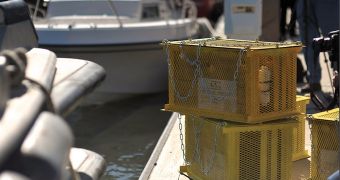This past Valentine's Day, a Napa Valley-based winery went public with the news that it was to soon debut a rather peculiar experiment.
Long story short, Mira Winery was getting ready to send four cases of 2009 Cabernet Sauvignon to the bottom of Charleston Harbor, South Carolina, and then try to figure out whether or not aging wine in the ocean might help improve its flavor.
“The ocean has similar ideal elements that impact aging – temperature, pressure, humidity, pressure motion, light — or lack thereof — and oxygen. Is there something just as impactful and interesting in aquaoir as there is about terroir? We are going to try and find out,” Gustavo Gonzalez, one of the people in charge of running this winery, argued at that time.
Recent news on this topic says that, this past Wednesday, said four cases of 2009 Cabernet Sauvignon did in fact make it all the way to the bottom of the ocean.
The cages holding the wine were especially designed for the purpose of keeping the beverage safe and sound, and factors such as light, pressure and temperature were given due consideration.
“On Wednesday, February 20 we submerged four cases of our 2009 Mira Cabernet Sauvignon into the Charleston, South Carolina harbor to learn what effect, if any, the ocean and it’s elements will have on the aging process of the wine,” reads the official press release concerning this experiment.
By the looks of it, the decision to force these wine cases into taking the plunge was a direct result of Mira Winery's learning that similar experiments had been carried out in Europe. Sources say that, commenting on this experiment, the President of Mira Winery, Jim Dyke, explained how, “It was born of the fact that we saw that some European wineries had experiments with both aging wine and storing wine in the ocean which we found interesting.”
The wine cases now resting at the bottom of Charleston Harbor will be allowed to age in this environment for a period of up to three months, after which they will be brought back to the surface and tested.

 14 DAY TRIAL //
14 DAY TRIAL //